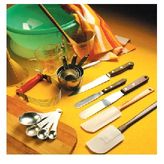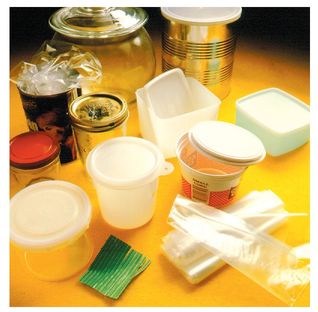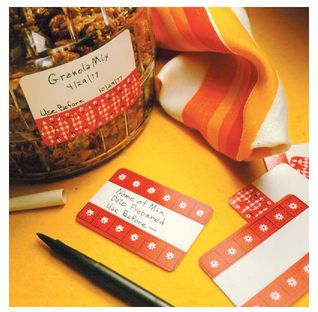Make-A-Mix (3 page)
Authors: Karine Eliason

Â
Sugar
âSugars contribute sweetness and tenderness to foods. In breads, sugar aids in producing a golden-brown crust. Small pinches of sugar added to certain vegetables increase their flavor. Granulated sugar is usually used in our recipes. Use powdered sugar, brown sugar, honey and molasses only when specified. They are
not
interchangeable with granulated sugar.
âSugars contribute sweetness and tenderness to foods. In breads, sugar aids in producing a golden-brown crust. Small pinches of sugar added to certain vegetables increase their flavor. Granulated sugar is usually used in our recipes. Use powdered sugar, brown sugar, honey and molasses only when specified. They are
not
interchangeable with granulated sugar.
Â
Spices
âSometimes the difference between an outstanding and a mediocre dish is the seasoning. Our recipes allow you to use a wide variety of herbs, seasonings and spices. For best results, use recently purchased, high-quality spices, because spices lose their flavor in a short time. When fresh spices and herbs are available, they are preferred to dried spices and herbs, but the amounts should be increased three to four times.
âSometimes the difference between an outstanding and a mediocre dish is the seasoning. Our recipes allow you to use a wide variety of herbs, seasonings and spices. For best results, use recently purchased, high-quality spices, because spices lose their flavor in a short time. When fresh spices and herbs are available, they are preferred to dried spices and herbs, but the amounts should be increased three to four times.
Â
Vegetables, Meats and Poultry
âUse care in preparing vegetables, meats and poultry for storage. It is essential to use fresh, clean, top-quality ingredients. Follow directions carefully for preparing and storing frozen mixes.
âUse care in preparing vegetables, meats and poultry for storage. It is essential to use fresh, clean, top-quality ingredients. Follow directions carefully for preparing and storing frozen mixes.
Â
Instant Nonfat Dry Milk
âWith milk solids added to a dry mix, you have the option of adding water to the recipe instead of milk. Adding milk gives extra enrichment and nutrition. Dried buttermilk powder can be used in some dry mixes, too.
âWith milk solids added to a dry mix, you have the option of adding water to the recipe instead of milk. Adding milk gives extra enrichment and nutrition. Dried buttermilk powder can be used in some dry mixes, too.
TIPS FOR LOWERING FAT
Â
In baked items substitute 2 egg whites for each whole egg.
Â
Use egg substitute instead of egg.
Â
Use skim milk in recipes calling for milk.
Â
Use nonfat or lowfat plain yogurt to replace some or all of oil in recipes.
Â
Use applesauce instead of oil in some baked breads or cakes.
Â
Use water or lowfat broth instead of oil for sautéing.
Â
Use vegetable cooking sprays instead of oil to brown meats and vegetables.
Â
Use lowfat or fat-free mayonnaise, sour cream and salad dressings.
Â
Substitute lowfat, plain yogurt for sour cream.
Â
Use more spices and herbs instead of butter and salt to flavor foods.
Â
Cut back on shortening and oil in breads. Usually you can get by with less without sacrificing quality.
Â
Use ground turkey or chicken instead of ground beef, but be sure to check the fat content. If it is ground with the skin on, that will make it almost as fat as beef. If you are unsure, have the butcher grind it for you without the skin. Fresh ground turkey or chicken must be used within 2 days of purchase or frozen for later use.
Â
Use leaner cuts of beef or pork.
Â
After browning ground beef, drain it in a colander and rinse it with hot water.
Â
Use lowfat or part-skim milk cheese in place of higher-fat cheese.
Â
Buy lowfat or fat-free versions of such foods as chicken or beef broth, refried beans, sauces, etc.
Â
Read labels carefully. Often foods tagged as
lite
or
healthy
are not really lowfat. According to experts, for a food to be considered lowfat, it should get 30% or less of its calories from fat.
lite
or
healthy
are not really lowfat. According to experts, for a food to be considered lowfat, it should get 30% or less of its calories from fat.
EQUIPMENT & PROCEDURES

Â
Cooking with Make-a-Mix recipes is very similar to the way you cook now. You probably already have all the equipment you need for measuring, mixing and storing the ingredients. You will spend a little extra time preparing your mixes, but you'll save much more time in the final preparation of recipes. Make up several mixes at a time. Because you're working mainly with dry ingredients, the clean-up will be minimal. In a short time, you can fill your shelves with an abundance of mixes that will make cooking more enjoyable for weeks to come.
Â
Measuring
âAccuracy in measuring ingredients is necessary to ensure satisfactory results in your cooking. You should have:
âAccuracy in measuring ingredients is necessary to ensure satisfactory results in your cooking. You should have:
set of dry measuring cups
liquid measuring cup with pouring spout
set of measuring spoons
straight-edged spatula
rubber scraper
liquid measuring cup with pouring spout
set of measuring spoons
straight-edged spatula
rubber scraper
Â
Dry ingredients should be measured in a cup with a flush rim for leveling. Lightly spoon ingredients into a cup and level with a straight-edged spatula.
Â
Liquid ingredients require a transparent measuring cup with markings and a pouring spout. Measure liquid ingredients at eye level.
Â
Moist ingredients such as brown sugar, soft breadcrumbs, grated cheese, coconut and raisins should be firmly packed so they hold the shape of the cup when turned out.
Â
Solid ingredients such as shortening should be pressed firmly into the measuring cup or spoon so no air pockets remain. Level with a straight-edged spatula. Use a rubber scraper to get all the shortening out of the measure.
Â
Mixing
âA real convenience in preparing mixes is a heavy-duty mixer. A small electric mixer or pastry blender will produce the same results but will require more effort. If you do not have a pastry blender, use 2 knives to distribute dry ingredients and fats evenly.
âA real convenience in preparing mixes is a heavy-duty mixer. A small electric mixer or pastry blender will produce the same results but will require more effort. If you do not have a pastry blender, use 2 knives to distribute dry ingredients and fats evenly.
Â
You will definitely need an extra-large mixing bowl. If you do not have a bowl large enough to hold about 35 cups (9 quarts) of mix, a round-bottom dishpan is an alternative.
Â
For dry mixes, stir all ingredients together until evenly distributed.
Â
For semi-dry mixes, evenly distribute the dry ingredients, then cut in shortening, butter or margarine until the mixture resembles cornmeal in texture.
Â
Storing
âFor maximum freshness, store dry mixes in airtight containers in a cool, dry and dark place. For freezer storage use containers allowing at least 1/2-inch expansion. Lightweight plastic bags and cottage-cheese cartons are not suitable for freezer use. Frozen mixes should be thawed in the refrigerator or microwave oven, and used immediately after thawing.
âFor maximum freshness, store dry mixes in airtight containers in a cool, dry and dark place. For freezer storage use containers allowing at least 1/2-inch expansion. Lightweight plastic bags and cottage-cheese cartons are not suitable for freezer use. Frozen mixes should be thawed in the refrigerator or microwave oven, and used immediately after thawing.
Â
Consider two methods of storing dry mixes. Large-Canister Storage lets you store your mixes in one or several large containers. This is especially useful for QUICK MIX, HOT ROLL MIX and other mixes that make a large number of recipes using different amounts. You can use large coffee cans lined with heavy plastic bags, large screw-top jars or airtight plastic containers or canisters.
Â
Premeasured Storage keeps just the amount you'll use in a specific recipe, so you won't have to measure it later. This is a good way to store meat mixes, seasoning mixes, SNACK CAKE MIX, MUFFIN MIX and any other mix that uses the same amount of mix in each recipe. Use plastic containers such as margarine tubs, drink-mix cans or any metal can with a lid, glass jars or heavy-duty-foil packets.
Â
Labeling
âBefore you place a mix on the shelf or in the freezer, make sure it is properly labeled. Resist the urge to store a mix, then label it later, because later the mixes may all look alike! On each container, write the name of the mix and the date by which it should be used. In most instances the mixes can be stored longer than the specified time, but at the risk of loss in flavor and nutrients. You may also want to write down the amount of mix in each container, particularly if you have divided the mix into premeasured amounts.
âBefore you place a mix on the shelf or in the freezer, make sure it is properly labeled. Resist the urge to store a mix, then label it later, because later the mixes may all look alike! On each container, write the name of the mix and the date by which it should be used. In most instances the mixes can be stored longer than the specified time, but at the risk of loss in flavor and nutrients. You may also want to write down the amount of mix in each container, particularly if you have divided the mix into premeasured amounts.

Â
1. Airtight canisters, jars and cans are useful for storing mixes. Freezer containers should allow for expansion of frozen mixes.

Â
2. On each mix container write the name and date by when mix should be used. Also record the amount of mix and recipe page number.
Dry & Semi-dry MixesBREADMAKER MIX
This mix can also be made by substituting whole-wheat flour for half of the white flour.
Â
13 cups bread flour
2 tablespoons salt
1/2 cup sugar
1/2 cup instant nonfat dry milk
Â
Â
Â
TO MAKE SMALL LOAF
1-1/2 teaspoons active dry yeast
2-1/4 cups BREADMAKER MIX
1 tablespoon butter or vegetable oil
3/4 cup warm water
Â
TO MAKE LARGE LOAF
2 teaspoons active dry yeast
3-1/2 cups BREADMAKER MIX
1-1/2 tablespoons butter or vegetable oil
1-1/4 cups warm water
Â
Mix and bake on LIGHT setting per breadmaker instructions.
Â
Combine all ingredients in a large bowl. Stir together to distribute evenly. Label and package in six (2-1/4-cup) containers, if using a 1-pound-loaf breadmaker, or in four (3-1/3-cup) containers for larger capacity bread makers. Store in a cool, dry place. Use within 6 months. Makes about 14 cups BREADMAKER MIX.
Â
Â
Â
Â
Variations
Cinnamon RaisinâTo the basic recipe add 1/2 cup raisins and 1-1/2 teaspoons ground cinnamon. Glaze with powdered-sugar glaze, if desired, while still warm.
Â
French BreadâEliminate the butter or vegetable oil.
Â
Sweet BreadâAdd 1 tablespoon of sugar with dry ingredients. Break 1 egg into measuring cup, fill cup with water to amount called for in recipe.
Â
Herb BreadâAdd 1-1/2 teaspoons dry herbs (rosemary, basil, dill, etc.)
BROWNIE MIXÂ
This has become a “best of all” recipe by the Ricks family. And as we demonstrate throughout the country, many others share that opinion.
Â
6 cups all-purpose flour 4 teaspoons baking powder 4 teaspoons salt 8 cups sugar 1 (8-oz.) can unsweetened cocoa powder
Â
BROWNIE MIX makes:
Chewy Chocolate Cookies, page 316
Our Best Brownies, page 314
Texas Sheet Cake, page 291
Brownie Alaska, page 315
Mississippi Mud, page 286
In a large bowl, combine flour, baking powder, salt, sugar and cocoa. Stir with a wire whisk until evenly distributed. Put in a large airtight container. Label with date and contents. Store in a cool, dry place. Use within 10 to 12 weeks. Makes about 15 cups BROWNIE MIX.
CORN BREAD MIXÂ
Corn bread baked in glass, castiron or a dark-metal pan develops a golden-brown crust.
Â
4 cups all-purpose flour
4 cups yellow cornmeal
2 cups instant nonfat milk powder or dry buttermilk powder
2/3 cup granulated sugar
4 tablespoons baking powder
1 tablespoon salt
1 tablespoon baking soda
Other books
Reaction by Lesley Choyce
Jules Verne by Robur the Conqueror
No sin mi hija by Betty Mahmoody, William Hoffer
The Cross Timbers by Edward Everett Dale
Morning Man by Barbara Kellyn
Payback by Kimberley Chambers
Vertigo by Pierre Boileau
The Marauders by Tom Cooper
The World Until Yesterday: What Can We Learn from Traditional Societies? by Diamond, Jared
Running Wild (Hell Ryders MC Book 1) by J.L. Sheppard
